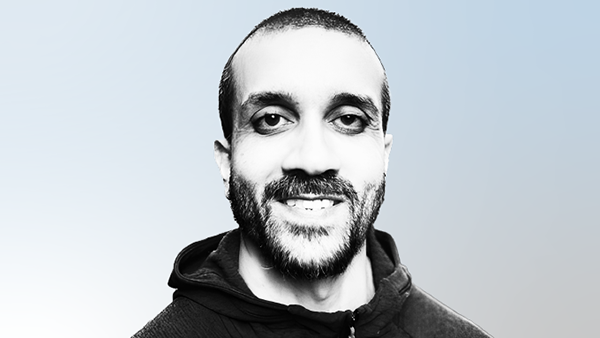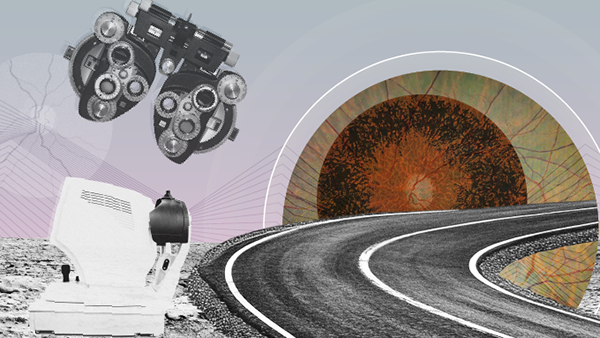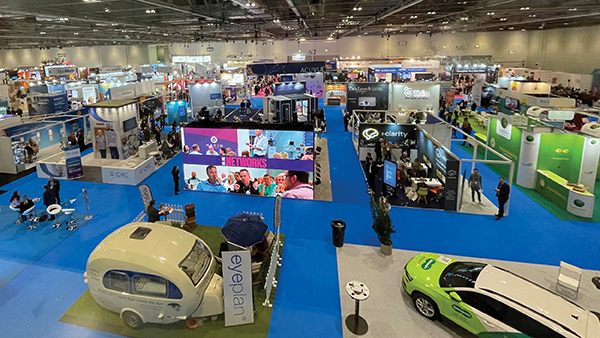How Dry Eye Disease Impacts Younger Patients
Primary and pre-op care can help the millions of young patients with DED
Although the prevalence of dry eye disease (DED) increases with age, its relationship isn’t exactly linear as the condition affects a significant portion of the population (1). This includes children and teens, 5.5 percent to 23.1 percent of whom have DED (2). Thus, regardless of age, it is essential to screen every patient for dry eye disease. Timely diagnosis, evaluation, and intervention are essential for primary care, as well as to prepare the ocular surface for surgery, the outcomes of which may be altered by refractive changes and other symptoms related to an unstable tear film.
Omnipresent screens, contact lenses, and other factors
I have diagnosed DED in patients as young as seven years old, as well as many teens and young adult college students. Extensive screen use (digital eye strain) is a major contributor (3). Most children under age eight exceed the established screen time recommendations for their ages (4), and teens average 4.8 hours per day on social media, in addition to school laptops and TV (5). It is not surprising, then, that a study of school children (mean age 12) showed 97 percent had at least one symptom of digital eye strain or dryness, most commonly eyelid heaviness (80 percent) and eye redness (69 percent) (6).
DED is also common in young contact lens wearers (3). Many other health, behavioral, and lifestyle factors contribute to the unexpectedly high rate of DED in this population, including poor sleep quality, allergies, smoking, medications (isotretinoin, oral contraceptives, antidepressants, oral antihistamines), poor diet or hydration, and environmental challenges (wind, very low humidity, air conditioning).
Treatments and modifications
Most young people are not accustomed to hearing they have a chronic condition. I keep the explanation simple and share images of their eyes so they can visualize the problem. To ensure that patients and parents follow my specific recommendations for therapy, I offer easy access to the products they need in the practice, as well as written instructions with QR codes for acquiring them online.
Healthy young people have a high capacity to respond to DED therapies and can often benefit from basic treatments and simple lifestyle changes.
- Contact lenses. Daily lenses ensure that teens start each day with a clean lens. In my experience, if patients wearing dailies are uncomfortable, contact lens-compatible DED therapies are often successful. These patients can also benefit from the addition of a preservative-free artificial tear that is compatible with contact lenses.
- Therapies for mild to moderate DED. I always recommend patients start with a high-quality, preservative-free artificial tear to lubricate the surface in the morning, at night, and as needed. iVIZIA (Thea) artificial tears, for example, give my patients immediate and long-lasting relief, and patients like the easy-to-use multi-dose bottle. For contact lens wearers, iVIZIA has been demonstrated to keep eyes more comfortable for a longer time without blurriness (7). Preservative-free Refresh Optive (Allergan) and Systane PF (Alcon) are good options as well. Another drop called Retaine MGD (OCuSOFT) stabilizes the tear film with electrostatic attraction, providing long-lasting treatment for DED associated with meibomian gland dysfunction (MGD) (8).
I also want young people to do eyelid hygiene every night; makeup removers, for example, can have ingredients that exacerbate DED. I recommend specific DED-friendly eyelid cleansers, such as iVIZIA micellar eyelid cleansing wipes, OCuSOFT Lid Scrub Plus foaming eyelid cleanser, or a variety of hypochlorous acid sprays.
We also discuss the importance of drinking water and getting plenty of sleep. Nutritional supplements such as Omega fatty acids are quite beneficial. In younger patients, I’m inclined to see if lifestyle modification factors such as eyelid hygiene, artificial tears, breaks on digital devices, adequate hydration, and sleep would work before adding another product to their regimen.
- Screen use modifications. Young people are often surprised to learn that they blink more than 60 percent less while reading or using digital devices (9), so it’s crucial to remember to blink regularly. I explain the 20-20-20 rule (every 20 minutes, take a 20-second break to blink and focus on something at least 20 feet away). Daily reminders such as setting a 20-minute reminder on their phone or laptop or having a sticky note on their laptop are beneficial for patients. We review best practices for optimal screen distance and viewing angle, along with tips on managing lighting, glare, and airflow from fans and air vents during screen use.
- Skin care and cosmetics. Many cosmetics and skin care products contain chemicals that can exacerbate or even cause DED. Facial cleansers, sunscreens, moisturizers, shave creams, makeup, and makeup removers are all potentially irritating. I offer patients a list of the most common eye irritants in these products: alcohol, acetyl hexapeptinde-3, benzalkonium chloride (BAK), butylene glycol, ethylenediaminetetraacetic acid (EDTA), formaldehyde and formaldehyde donors, isopropyl cloprostenate, parabens, phenoxyethanol, and retinol. The handout also lists ingredient-conscious eye makeup brands, such as Blinc, Eyes are the Story, Eye Ecco, Twenty Twenty Beauty, and We Love Eyes.
- Therapies for more severe cases. In moderate to severe cases, a systemic evaluation to rule out autoimmune and thyroid disease is essential, particularly after adolescence. I advise a combination of therapies in severe cases. In addition to preservative-free artificial tears and lifestyle modifications, therapies can potentially include punctual plugs; prescription medications such as perfluorohexyloctane (Miebo, Bausch & Lomb), lifitegrast (Xiidra, Bausch & Lomb), cyclosporine (Restasis, Allergan) or varenicline (Tyrvaya, Viatris); lotilaner (Xdemvy, Tarsus), a medication for demodex blepharitis; and in-office procedures such as thermal meibomian gland expression (TearCare, Sight Sciences) or IPL (OptiLight, Lumenis). Other options include scleral lenses, autologous serum, amniotic membranes, and night goggles.
Many of my young patients who experience headaches and digital eye strain find relief after receiving an updated prescription and addressing their DED symptoms. It is critical to ensure that young patients continue to have regular dilated eye exams for evaluating ocular health, maintaining optimal vision, and managing DED.
A 19-Year-Old College Student’s First Eye Exam
A 19-year-old patient came to me for her first ever eye exam because her distance and near vision were decreasing. She experienced eye strain when using the computer, which she did 8 hours per day. She did not complain of DED symptoms, yet her score on the OSDI questionnaire was 14 (mild DED). The patient had no relevant medical history, used no oral or topical medications, and had no known drug allergies.
Without correction, her vision was OD 20/20-1, OS 20/20-1. Refraction was plano OD/OS, and entrance testing was normal. Slit lamp examination revealed that the patient had 2+ MGD, no conjunctival injection, no corneal staining, oily tear film, and a six-second tear breakup time. The posterior segment examination was normal.
I concluded that the patient had mild DED and MGD, with blurry vision due to an unstable tear film. We discussed the importance of tear film homeostasis and how the patient’s screen habits were contributing to chronic DED. We discussed the 20-20-20 rule for digital devices. I suggested using iVIZIA micellar eyelid cleansing wipes, prescribed perfluorohexyloctane (Miebo, Bausch & Lomb) four times a day, and iVIZIA artificial tears as needed. When the patient returned one month later, her eyes were feeling better, she was no longer having vision problems, and she had less eye strain with computer work. Her tear film quality and MGD were improved in each eye, and TBUT improved to 9 seconds. I advised her to continue her current regimen.
References
- F Stapleton et al., “TFOS DEWS II Epidemiology Report,” Ocul Surf.,15, 334 (2017). doi:10.1016/j.jtos.2017.05.003
- F Stapleton et al., “Dry eye disease in the young: A narrative review,” Ocul Surf., 31, 11 (2024). doi:10.1016/j.jtos.2023.12.001
- F Stapleton et al., “TFOS lifestyle: Impact of societal challenges on the ocular surface,” Ocul Surf., 28, 165 (2023). doi:10.1016/j.jtos.2023.04.006
- MH Trinh et al., “Association of Trajectory and Covariates of Children's Screen Media Time,” JAMA Pediatr, 174, 71 (2020). doi:10.1001/jamapediatrics.2019.4488
- BJ Rothwell, “Teens spend average of 4.8 hours on social media per day,” Gallup.com. news.gallup.com/poll/512576/teens-spend-average-hours-social-media-per-day.aspx Published February 9, 2024.
- JS Wolffsohn et al., “TFOS Lifestyle: Impact of the digital environment on the ocular surface,” Ocul Surf., 28, 213 (2023 ). doi: 10.1016/j.jtos.2023.04.004. Epub 2023 Apr 14. PMID: 37062428.
- Thea data on file.
- G Ousler III et al., “An evaluation of Retaine ophthalmic emulsion in the management of tear film stability and ocular surface staining in patients diagnosed with dry eye,” Clin Ophthalmol., 9, 235 (2015). Published 2015 Feb 5. doi:10.2147/OPTH.S75297
- NC Chidi-Egboka et al., “Blink Rate Measured In Situ Decreases While Reading From Printed Text or Digital Devices, Regardless of Task Duration, Difficulty, or Viewing Distance,” Invest Ophthalmol Vis Sci,64, 14 (2023). doi:10.1167/iovs.64.2.14
The New Optometrist Newsletter
Permission Statement
By opting-in, you agree to receive email communications from The New Optometrist. You will stay up-to-date with optometry content, news, events and sponsors information.
You can view our privacy policy here
Most Popular
Sign up to The New Optometrist Updates
Permission Statement
By opting-in, you agree to receive email communications from The New Optometrist. You will stay up-to-date with optometry content, news, events and sponsors information.
You can view our privacy policy here
Sign up to The New Optometrist Updates
Permission Statement
By opting-in, you agree to receive email communications from The New Optometrist. You will stay up-to-date with optometry content, news, events and sponsors information.
You can view our privacy policy here







